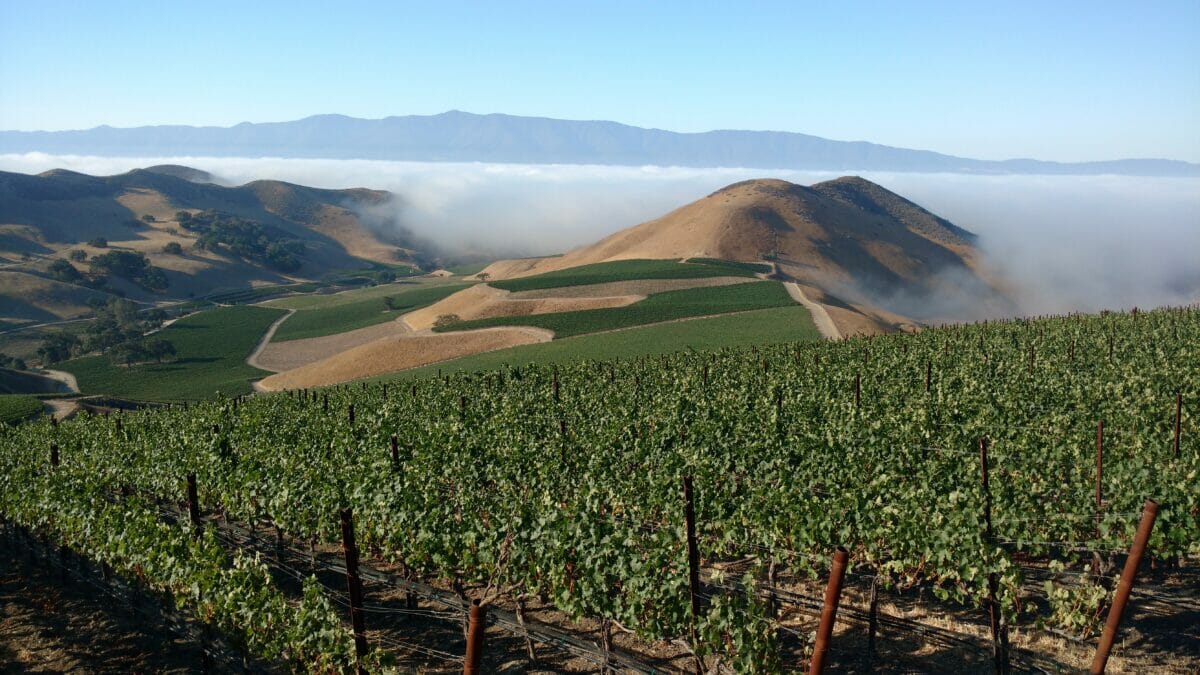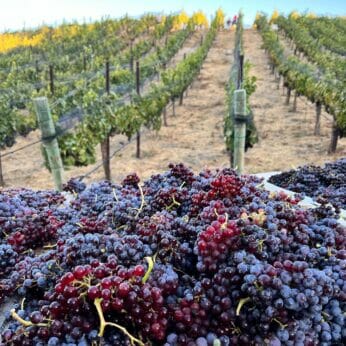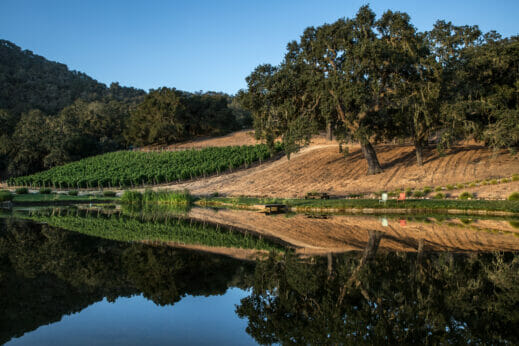To Cultivate Modern Sustainability, A California Wine Region is Turning to Very Old Methods
Are Santa Ynez Valley’s own-rooted vines the key to surviving an increasingly dry future?
To Cultivate Modern Sustainability, A California Wine Region is Turning to Very Old Methods
Are Santa Ynez Valley’s own-rooted vines the key to surviving an increasingly dry future?

Star Lane Vineyards uses both own-rooted and grafted vines. courtesy of Star Lane Vineyards
Ask any of the wine grape growers planting own-rooted stock why they’re farming these massively risky grapevines and they’ll all tell you the same thing: They just want to make really great wine. But there’s another benefit to the gamble, too—unlike most American wine grapes, which are overwhelmingly grown on grafted rootstock, own-rooted vines are especially drought-tolerant, produce a more predictable crop and use significantly fewer resources.
There’s a huge downside to using own-rooted vines, though. If they get attacked by phylloxera, the entire crop will die. It won’t be a loss of just one season’s grapes—the entire vineyard itself will be totally destroyed. And the invasive species is present in the soil in vineyards throughout America. In fact, phylloxera nearly wiped out French wine grapes more than a century ago. The fix was to graft European vitis vinifera vines onto American rootstock, which can withstand the root damage from phylloxera. It’s also how European varieties of wine grapes can thrive in America.
But Santa Ynez Valley, a winemaking region on California’s Central Coast, is uniquely suited to keep phylloxera at bay. Just 125 miles north of Los Angeles, the valley’s relatively low rainfall and high average temperatures help foster an inhospitable environment to the pest. But more than anything, it’s the soil. Santa Ynez Valley is only 35 miles inland from Santa Barbara’s coastline.
“This is beach sand at the top of every one of these hills,” says Noah Rowles, gesturing to the 250 acres of his Thompson Vineyard. “It’s literally like hourglass sand. The last time the ocean was at its highest, this was the top of the Pacific.” Rowles has 43 acres of Rhone varietal grapes such as Grenache and Syrah, which he uses to make his Dovecote wine. The vineyard has been all own-rooted since it was first planted in 1989 by the original owners.

Even though own-rooted vines are vulnerable to phylloxera, there are huge advantages to growing plants on their own roots, rather than on the more commonly used grafted stock. They display a hardiness and stability that allows them to survive better in times of drought and extreme heat. That innate balance likely comes from the fact that own-rooted plants are higher vigor, meaning that the plants themselves and the roots tend to grow bigger than lower-vigor grafted stock. Vigor is a primary concern with grapevines, in particular, because high-vigor vines produce more leaf canopy, and they grow more grapes — which, counterintuitively, is bad for wine. The fewer grapes a vine produces, the more concentrated the flavor and the better the wine in the bottle. Traditional viticultural wisdom is to plant low-vigor vines, which inherently produce fewer grapes, and then intentionally stress them to further concentrate their fruit by providing just enough water and nutrients to survive.
While the grapes grown from grafted rootstock produce excellent wine, the vines are fragile. They take a lot of resources to maintain and are especially susceptible to external factors like weather. Even in the best of circumstances, the plants tend to die out, although the time frames vary wildly. Some die after 30 years, while others last much longer.
It’s not exactly known why phylloxera isn’t as much of an issue in the Santa Ynez Valley, but Chris Greer, PhD, a University of California integrated pest management advisor, has some theories. Greer points to a 1928 USDA study. “It’s almost 100 years old,” he says, “but it’s a pretty extensive study on phylloxera infestation in California as related to types of soils. It’s pretty much saying the same thing that most people are saying today … In sandier soils, it’s less of a problem.”
Greer says that it’s not precisely clear why phylloxera doesn’t thrive in sandier soils; it’s likely that the elements in clay soil that allows it to live—cracks in the topsoil for easy burrowing and air pockets beneath the surface—aren’t present. Sandy soil is coarser and tends to settle in on itself, so there are fewer places for the pests to burrow into and fewer places for them to live once they do.
“This thing doesn’t move long distances on its own, like some of our other pests,” Greer adds. “So if you think about having a vineyard that doesn’t have phylloxera, you’re probably in pretty good shape if you can keep it out of there.”

That’s what Tyler Thomas, winemaker and president of Dierberg and Star Lane Vineyards, is doing. He keeps both own-rooted and grafted stock relatively close to each other in Star Lane’s vineyards, but he isn’t substantially concerned with contamination. The winery’s growing area in Happy Canyon is isolated, and the vineyard propagates new vines from existing plants on the property rather than buying from a nursery. Risk of a problematic pest finding its way into the vineyard is low.
What started with a few blocks of Cabernet grapes has now become Cab, Chardonnay, Merlot and Cabernet Franc, totaling about 22 acres of own-rooted vines. “When I first told my colleagues from Sonoma and Napa that I had own-rooted Cab, they were like ‘is it dead yet?’ That’s sort of the default assumption,” says Thomas. “And it’s actually doing very, very well. You do not need to be an expert to look at the vines and say, ‘something’s different here.’”
Blair Fox, owner and winemaker of Blair Fox Cellars, own-roots Syrah, Zinfandel and Petite Sirah at his vineyard in Los Olivos. “We were seeing a lot of incompatibility issues with Syrah on other rootstocks around the county—around the state, really,” says Fox. So he started own-rooting and has seen a level of stability and fortitude with the own-rooted plants that he doesn’t see with grafted stocks.
Fox is also head winemaker at Fess Parker Winery, also in the valley. Whereas other vineyards he works with see variation in crop yields and canopy growth on grafted vines, his own-rooted vines and those he’s planted at Fess Parker show steadier results.
There are many contributing factors, such as location, geography of the vineyard, micro-climate and soil composition, but he believes that own-rooted vines in Santa Ynez County do tend to thrive, especially over the droughts and extreme heat waves in the last few years. “They react better to drought. They react better to heat stress. They react better to basically all the problems that we’re seeing now,” says Fox. “I’m seeing vines on other rootstocks actually shutting down, because I think that rootstock itself is not able to handle the lack of water or the extreme heat.”
Noah Rowles at Dovecote also sees less variation from year to year in the ripening timeline and overall crop yields. “What I hear from other farmers and winemakers is that own-rooted vines are more normalized,” he says. Because they survive better in drought, they produce more grapes in drought years than plants that need more water. In rainy, high-yield years, they produce fewer grapes. “You have less variation in yield from vintage to vintage,” he says.
Own-rooted blocks are easier to keep alive than grafted stock, which necessarily has scar tissue because of the graft. They have a hardy root structure, and if one single plant starts to fail, it’s simple to take a clipping from nearby and propagate it. That way, you’re not spending money on new plants, and you’re not exposing the ecosystem to new invasive species.
“When they’re allowed to be connected to their own roots, plants are going to survive indefinitely,” says Rowles. “That’s one of the things I love about own-rooted sites. If a vine gets a disease or needs to be replaced, you just bring in a cane from the neighboring vine and put it down into the soil and just continue on.
“With rootstock, you have to replant every 20, 30, 40 years,” he adds. “That’s a huge amount of resources that have to be put in every time you restart. It’s tons of waste.”

Economics were definitely a contributing factor for Max Marshak’s decision to plant own-rooted vines at Refugio Ranch Vineyards and Roblar Winery. He is winemaker for both wineries, in Los Olivos and Santa Ynez, respectively, and for Buttonwood Farm Winery in Solvang, a totally own-rooted estate winery the company recently acquired.
“The primary benefit for me is that it makes us self-reliant in many ways,” says Marshak. “Most of modern viticulture, if someone wants to plant or replant a vineyard, they’re at the mercy of a limited number of nurseries who provide rootstock … They’re buying bench-grafted vines that can cost $5 apiece. The cost benefit to being able to propagate your own vines from cuttings is fantastic.” Vine density varies by grower, but Marshak is planting more than 2,000 vines per acre—grafted stock would cost the winery about $10,000 per acre in plants alone. Across Refugio’s 27 acres, that’s a substantial investment.
The own-rooted blocks of Grenache at Refugio aren’t in sandy soil, they’re in a low-lying river plane by the Santa Ynez River. What’s keeping pests out of the area, says Marshak, is the vines’ ability to propagate themselves, so no new, potentially contaminated outside plants come in. “In the spring, they push new shoots out without us even having to worry about them,” he says. “Because the genetic material goes right down into the soil, the chances for it to reproduce itself are high. There’s a resilience built into the own-rooted system that we really like.” Those vines, he explains, “tend to get established more rapidly and tend to grow more vigorously. That extra hardiness and durability is a real advantage as vineyards age.”
Tyler Thomas from Star Lane says there are lessons to be learned from own-rooted farming that can be applied to viticulture in Santa Ynez Valley more broadly. He estimates that his own-rooted plants use about half the water of grafted stock. “They’re forecasting about a 15% drop in precipitation in this area in the next 25 years,” he says. “That’s really altering how we think about redevelopment strategies. We want a healthy vine that we control the stress [level of], not a vine that’s stressed because it’s unhealthy.”
Seeing those plants thrive under climate stress has shifted his thinking for grafted stock. “The own-rooted vines have taught us it’s OK and safe in this area for us to use much more vigorous rootstock than were originally planted,” he says. Seeing vines with bigger, water-scavenging root systems produce high quality wines, when all winemaking wisdom has traditionally said the opposite, is opening his mind to possibilities for a future with increasingly unpredictable weather and scarce resources.
“We have done some replanting in the last couple of years where we have not necessarily used own-rooted vines, but we’ve used the same principle and selected higher-vigor rootstocks than the original plantings” in Star Lane Vineyard, he explains. “We’ve seen those vines establish more quickly, we’ve seen that they don’t acquire as much irrigation or nutrition. That means pumping less water out of the ground, which is better for the water table, but [it] also requires less carbon emissions. And we’ve made some wine off of those new developments now, and it’s excellent.
“I think it’s a way to advance quality in our area,” says Thomas. “Those kinds of rootstock really should be where we move toward, I think.”
Follow us
This work is licensed under a Creative Commons Attribution-NoDerivatives 4.0 International License.
Want to republish a Modern Farmer story?
We are happy for Modern Farmer stories to be shared, and encourage you to republish our articles for your audience. When doing so, we ask that you follow these guidelines:
Please credit us and our writers
For the author byline, please use “Author Name, Modern Farmer.” At the top of our stories, if on the web, please include this text and link: “This story was originally published by Modern Farmer.”
Please make sure to include a link back to either our home page or the article URL.
At the bottom of the story, please include the following text:
“Modern Farmer is a nonprofit initiative dedicated to raising awareness and catalyzing action at the intersection of food, agriculture, and society. Read more at <link>Modern Farmer</link>.”
Use our widget
We’d like to be able to track our stories, so we ask that if you republish our content, you do so using our widget (located on the left hand side of the article). The HTML code has a built-in tracker that tells us the data and domain where the story was published, as well as view counts.
Check the image requirements
It’s your responsibility to confirm you're licensed to republish images in our articles. Some images, such as those from commercial providers, don't allow their images to be republished without permission or payment. Copyright terms are generally listed in the image caption and attribution. You are welcome to omit our images or substitute with your own. Charts and interactive graphics follow the same rules.
Don’t change too much. Or, ask us first.
Articles must be republished in their entirety. It’s okay to change references to time (“today” to “yesterday”) or location (“Iowa City, IA” to “here”). But please keep everything else the same.
If you feel strongly that a more material edit needs to be made, get in touch with us at [email protected]. We’re happy to discuss it with the original author, but we must have prior approval for changes before publication.
Special cases
Extracts. You may run the first few lines or paragraphs of the article and then say: “Read the full article at Modern Farmer” with a link back to the original article.
Quotes. You may quote authors provided you include a link back to the article URL.
Translations. These require writer approval. To inquire about translation of a Modern Farmer article, contact us at [email protected]
Signed consent / copyright release forms. These are not required, provided you are following these guidelines.
Print. Articles can be republished in print under these same rules, with the exception that you do not need to include the links.
Tag us
When sharing the story on social media, please tag us using the following: - Twitter (@ModFarm) - Facebook (@ModernFarmerMedia) - Instagram (@modfarm)
Use our content respectfully
Modern Farmer is a nonprofit and as such we share our content for free and in good faith in order to reach new audiences. Respectfully,
No selling ads against our stories. It’s okay to put our stories on pages with ads.
Don’t republish our material wholesale, or automatically; you need to select stories to be republished individually.
You have no rights to sell, license, syndicate, or otherwise represent yourself as the authorized owner of our material to any third parties. This means that you cannot actively publish or submit our work for syndication to third party platforms or apps like Apple News or Google News. We understand that publishers cannot fully control when certain third parties automatically summarize or crawl content from publishers’ own sites.
Keep in touch
We want to hear from you if you love Modern Farmer content, have a collaboration idea, or anything else to share. As a nonprofit outlet, we work in service of our community and are always open to comments, feedback, and ideas. Contact us at [email protected].by Julie Tremaine, Modern Farmer
March 14, 2023
Modern Farmer Weekly
Solutions Hub
Innovations, ideas and inspiration. Actionable solutions for a resilient food system.
ExploreExplore other topics
Share With Us
We want to hear from Modern Farmer readers who have thoughtful commentary, actionable solutions, or helpful ideas to share.
SubmitNecessary cookies are absolutely essential for the website to function properly. This category only includes cookies that ensures basic functionalities and security features of the website. These cookies do not store any personal information.
Any cookies that may not be particularly necessary for the website to function and are used specifically to collect user personal data via analytics, ads, other embedded contents are termed as non-necessary cookies.
Not all rootstock is the same, as your last paragraph indicated. Various rootstock provide different a
properties. While some are more phylloxera resistant, others might be more drought resistant. And still others might provide more vigor. When planting a vineyard on rootstock, careful consideration of the needs of the vineyard should be taken into account to get the best results.
Also, within the last few years, a study out of the Oregon State University Extension Service shows that dropping fruit generally does not make better wine.
2,000 vines per acre? That’s only 21 sqft/vine. At 7 ft between rows that is less than 3 ft of fruiting space for each vine. With 4” between spurs there can only be 12 spurs or 24 shoots or 48 clusters per vine. Why plant so densely?